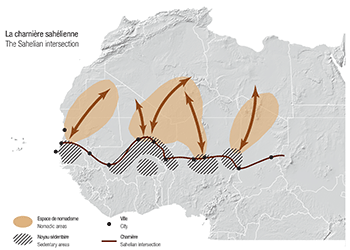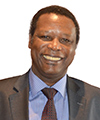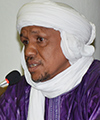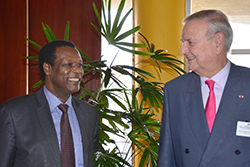Sahel and West Africa Week 2013 › SWAC Forum : The Future of the Saharo-Sahelian areas
SWAC Forum : The Future of the Saharo-Sahelian areas
 |
Abidjan, 28 November 2013 Bringing together a representative panel of stakeholders, the Forum offered a platform for dialogue on the development potential of the Saharo-Sahelian areas and the impact of increased co-operation between North, West and Central Africa, in particular in the field of security. Capitalising on the debates and analyses underway since Mid-2013 (POAESS), the SWAC Secretariat will prepare an Atlas within the OECD West African Studies series. |
 |
|
About the Forum
|
The Forum brought together about 100 political decision-makers, high-level representatives of international and regional organisations, researchers and local stakeholders. The event was structured into presentations of research results, that explored the political, security, economic and geographic characteristics of the Sahara-Sahel region. These presentations were followed by panels dedicated to political debate, in the interest of sharing knowledge. In the panels, three or four speakers lead discussions on the need to revisit policies and practices to better tackle the socio-economic and security challenges of the area. The Panels explored the overlapping geographical (local, national, regional, and their interlinkages) and time scales (short, medium and long-term) involved in current dynamics, challenges and solutions. |
AU High Representive for Mali and the Sahel H.E. President Buyoya and SWAC President De Donnea > more images |
The Panels focused on:
- Assessing “security and development” initiatives, their coherence and their capacity to intervene at the correct scale;
- Exchanging experiences between development and security experts, economic and political actors, and researchers;
- Discussing innovative forms of co-operation and sustainable solutions, their mechanisms and scales of action, to promote development and security for the populations of the Saharo-Sahelian areas.
Agenda
Session 1: Political and geographical trends of the Sahara-Sahel area
Presentation 1: Instability and regional geopolitics
Most past conflicts in the region were localised in space; current crises, however, are transnational , pointing towards a transnational resolution. Does this by itself explain the intensity of current crises? A review of the factors and actors involved, of recent political events (coups d’états, revolutions) affecting the relations between North and West Africa was presented. Which solutions fit which geographical dimensions? What role should borders play?
Presentation 2: A geographical history based on mobility
The growth and diversification of mobility in the Saharo-Sahelian region renew and multiply the junctures between the North African and the Sahelian banks of the Sahara. What role do networks play in the development of mobility and how does mobility shape territories (structuring or destructuring)?
Presentation 3: Nomadic communities and their socio-economic evolution
An analysis of the identities and the socio-political organisation of nomadic communities (pastoral, agro-pastoral, trader, caravanner, etc.) allows us to better understand the evolution of their livelihoods. Nevertheless, with their future dependent on regional and global challenges, these constantly evolving nomadic communities are important factors in the stability of the region. How to transform risks into opportunities in the effort to consolidate relations between North and West Africa?
Debates
Panel 1: Security and development” initiatives and transnational challenges; what are the views of the research community?
Questions for the panel: Are the political dialogue and action tools of the “Sahel strategies” and “Security and Development” initiatives in the region adapted (temporally, geographically, and operationally) to the current tensions?
Debates
Session 2: Economic realities, political dialogue and outlook for co-operation in the Saharo-Sahel area
Presentation 4: The history of political and economic relations
Since the end of the 1990s we observe among North African countries a renewed interest in their southern neighbours, in the form of economic and trade agreements, security co-operation, and regional organisations. Nevertheless, the Maghreb and the Machrek continue to prioritise Europe and the world, while trans-saharian trade remains weak. How to construct or reconstruct a common space?
Panel 2: How to strenghten the economic relationship between Saharo-Sahelian countries?
Questions for the panel: What medium and long term economic interests do the countries on the two banks of the Sahara share? What potentials to rely on, where to invest, and what dialogue tools should be used for an adequate and sustainable response? What is the political outlook for the trans-saharian co-operation?
Debates
Panel 3: How to build coherent policies for sustainable peace?
Panelists from international and regional organisations will share their visions on how shared and coherent co-operation can be built and promoted on the basis of existing and future initiatives. The panel discussed the spatial and time dimensions of the current challenges and how they can be integrated and operationalised in security and development projects. Participants explored options for consensus on innovative approaches and tools for coherent policies for sustainable peace.
Debates
Debates
The debates highlight the following:
- The security threats that weigh on the Saharo-Sahelian areas are transnational in nature, and they affect West, Central and North Africa and the international community.
- The dynamics of the current conflicts are complex and multidimensional. They can only be thwarted by strategies that articulate the short, medium and long-term, and that take into account that security and development concerns are intrinsically linked, and that adapt responses to these realities.
- The Saharo-Sahelian areas dispose of shared potentials able to guarantee the common development, and to support the development of the countries and regions that they belong to.
Presentations
 |
Instability and regional geopolitics (French)
by Olivier Walther, Visiting assistant professor, Division of Global Affairs, Rutgers University
|
 |
A geographic history based on mobility I (French)
by Denis Retaillé, Professor, University of Bordeaux/CNRS
PPT forthcoming |
 |
A geographic history based on mobility II (French)
by Ali Bensaâd, Lecturer, University of Aix-Marseille
PPT forthcoming |
 |
by Laurent Gagnol, Research associate, Laboratoire PACTE, University J. Fourier of Grenoble
|
 |
History of political and economic relations (French) by Antonin Tisseron, Research fellow, Thomas More Institute |
 |
Cross-border infrastructure and its impact (French) |
Viewpoints
What strategy for the Sahel?
If the definition of one integrated strategy shared by all actors remains but a dream, a harmonisation of strategies and a reflection on common concerns are within reach. When strategies are defined in emergency situations, are they negotiated with the relevant countries and regional institutions? How can the objectives of the fight against terrorism and the objectives of development be made to converge? What are the adequate geographic scales of intervention? What are the appropriate mechanisms for implementing and financing multilateral initiatives?
 |
Pierre Buyoya, AU High-Representative for Mali and the Sahel “The strategy of the African Union aims to address three major challenges: security, governance and development, including the humanitarian aspects. How to encourage co-operation in the field of security between the countries of the Sahel and of the Sahara-Sahelian areas? This strategy is implemented through what we call the Nouakchott process. Firstly, we aim to create, together with the countries of the region, a co-operation mechanism at the strategic and operational levels in order to address the security problems that we encounter. Secondly, what are the common governance issues of the region? For example, religious radicalisation, decentralisation, issues related to the marginalisation of minorities, the problem of youth employment, etc. We try, together with the countries of the region, to deepen the reflections on how to deal with these issues. The third pillar of our strategy is based on the economic development. We must recognize that security and development are two sides of the same coin. Insecurity in the Sahel is closely linked to poverty and we need to improve the resilience of populations through programmes aimed at strengthening agriculture, the livestock sector and the fight against climate hazards. We can then address issues to transform in the long term the economic face of the region.” |
 |
Michel Reveyrand de Menthon, EU Special Representative for the Sahel “The EU was the first major institution to have developed a strategy for the Sahel that links closely security and development: « No security without development and no development without security”. [...] One of the major challenges today is how to create a regional approach to this Sahara-Sahel crisis. The international community must put in place a framework for managing these crises at the right scale. There are two approaches that can be combined and reinforce each other: one approach is to try to help the States concerned - the states of the Sahel and Sahara - to establish co-operation among themselves at the level of the crisis, particularly in the field of security. It is very important that all States concerned work together; for example, by creating a platform for dialogue or a framework for regular meetings at the level of the Sahara-Sahelian areas. The other aspect concerns the co-ordination of members of the international community that are interested in these crises [...] All these players must find their place, co-ordinate their actions... we must agree on the essentials - we actually do agree on the essentials and that is why we can be optimistic today about the advance of this regional agenda.” |
 |
Peter Robert Sampson, Head of Mediation Support/Advisor, UNOWA “Over the last two years, the UN Integrated Strategy for the Sahel has basically metamorphosed from what was a strategy based on a reaction to the crisis in Libya, to a strategy based on a reaction to the crisis in Mali, and up until now evolving into a strategy that is focused on the needs of the Sahel. The UN strategy is based on three pillars: governance, security and resilience as well as a focus on support for infrastructure. It has a geographic coverage that stretches from Eritrea to Mauritania but with five core countries at the heart of it. Its implementation is co-ordinated by UNOWA. Following the approval of the strategy, the joint visit of the UN, the EU, the World Bank, the African Development Bank and the Islamic Development Bank to the Sahel was a key step towards a coherent approach. The visit illustrated first of all the awareness of the international community to the situation in the Sahel; it resulted in the setting up of a joint co-ordination mechanism, and in addition, it provided also an opportunity for countries to articulate their own priorities within each of those three pillars.” |
 |
Lori-Anne Théroux-Bénoni, Senior Research Fellow, ISS Dakar “At present, there are almost a dozen strategies for the Sahel that have been developed or are currently being developed by different actors such as partner states, international organisations, financial institutions, or the Sahelian states themselves. The growing number of strategies is not a problem in itself. The problem is rather to ensure that there is overall coherence between these strategies and, ultimately, make sure that the interests of foreign partners not only respond to their own interests but also to the interests of the target countries both at the government level and at the level of local communities.” |
What are the prospects of Trans-Saharan co-operation?
Participants underlined the need to rethink how States can co-operate on a trans-border and trans-national level around the three challenges faced by the Sahel: security (the strength of armed groups vs. the weakness of States); governance (weakness of budgets allocated to justice and the military); and development (in particular, poverty and food insecurity). There are some promising areas for action, for example, in the field of decentralisation, cross-border co-operation and infrastructure development. Here are some viewpoints:
 |
Abdourahamane Maouli, Mayor of Arlit, Niger “Most of the situations that we are currently facing derive from one key problem: poverty, misery and lack of means to deal with the situation. I think that the development of communication infrastructure, such as road infrastructure or telecommunications, would boost our economy and thus help develop our region. [...] We also need to build trust. Without trust, all efforts are doomed to failure. Decentralisation efforts must be deepened in order to strengthen direct contact with the populations and support our communities.” |
 |
Antonin Tisseron, Doctor of History and Researcher Fellow of the Institut Thomas More “We must be pragmatic and work with actors on specific programmes in which they wish to participate. Indeed, on the one hand, the existing structures are poorly functioning and on the other, they are marked by mistrust and rivalry between the Maghreb countries – in particular Morocco and Algeria - but also between Sahelian countries. We are thus facing a difficult situation in which we must try to gradually move forward. For example, by making headway at the bilateral level while building, in parallel, a forum to improve co-ordination at the political level.” |
 |
Denis Retaillé, Professor of Geography, University of Bordeaux/CNRS “For many years, the Sahara has remained a blank spot on the map. As this blank spot has been filled with information, the Sahara appears to be empty. However, the Sahara is not empty; it is widely traversed, and rather than insisting on the small size of its population, we should look at the strength of the activity and dynamism that prevails there due to the constant crossings. The Sahara-Sahelian area is an open and animated space. Security and development are best anchored in this vibrancy created by mobility rather than in partitioning and concentrating on a few mining/exploration sites that are directly connected to the outside world. Mobility is a guarantee of integration.“ |
 |
Olivier Walther, Visiting Assistant Professor, Division of Global Affairs, Rutgers University, USA “In studying the Malian conflict, we sought to understand how individuals with such different goals (MNLA against AQIM) were able to unite against the government of Bamako. We chose to analyse these alliances through social networks. The actors are extremely flexible in their social and spatial strategies. Institutional initiatives could draw lessons from this flexibility to promote development and security in the region.” |
 |
Ali Bensaâd, Lecturer, University of Aix-Marseille “There is a process of deep interpenetration between the Maghreb and the Sahel. It may seem paradoxical to say so when we see how the States of both sides turn their back on each other. However, we can observe the reality of this phenomenon on the ground where thriving networks of informal trade, outside state control, are flourishing. They follow the same pattern as the oases that under the trans-Saharan trade were not hydro-agricultural systems but rather hubs in a relational system. Today, the exchanges are reviving this system. Often States do not want to see this reality.”
|
 |
Salim Chena, Associate Editor of the review “Dynamiques internationales” “Meetings such as the SWAC Forum, help promote awareness of the need to encourage closer co-operation between North Africa, West Africa and the Sahel with a view to managing the common challenges they are facing. That being said, there is a true demand because countries do co-operate, - even if they tend to co-operate at the bilateral level rather than all together. To move forward, there is also the possibility of working together on very particular and specific issues that directly affect the parties concerned without pinpointing or crystallizing the differences that may exist and which are also legitimate between sovereign states. Looking forward, there are obviously still a lot of things to be done, in particular improving co-ordination between the different programmes and organisations active in the region. But it is a step in the right direction to eventually address the many problems and challenges facing this region by the primary actors concerned who are the sovereign states of these large spaces.” |
Viewpoints collected on 28 November 2013.
Sahel Strategies & Documents
- European Union External Action Service (EEAS) Strategy for Security and Development in the Sahel, March 2011
- UN 2013 Sahel Regional Strategy, December 2012
- AU Strategy for the Sahel, currently under elaboration
- ECOWAS Strategy for the Sahel, currently under elaboration
- Mali: Strategy for the Sustainable Renewal of Mali 2013-2014, May 2013
- Niger: SDS-Sahel-Niger: Strategy for security and devlopment of the Saharo-Sahelian areas
- USAID Sahel JPC Strategic Plan, 2012
- Final Declaration of the Elysee Summit on Peace and Security in Africa, 7 December 2013
Useful links
- AfDB President Kaberuka blog on "Getting it right in the Sahel"
- AU Peance And Security Unit > http://www.peaceau.org
- European Union External Action - Sahel > http://eeas.europa.eu/crisis-response/where-we-work/sahel/index_en.htm
- UN Documents for Mali/Sahel > http://www.securitycouncilreport.org/un-documents/malisahel
- Sahel Intelligence : http://sahel-intelligence.com
High-level Meetings
- Security Council Discusses Situation in Sahel, 26 June 2013
- Security Council Discusses Situation in Sahel, 16 July 2013
- High-level Meeting Held on Sahel Region, 26 September 2013
- UN Secretary-General Addresses Ministerial Meeting on Sahel, 5 November 2013
- Regional Conference on Security in the Sahel, Rabat, 14 November 2013
Related Documents



